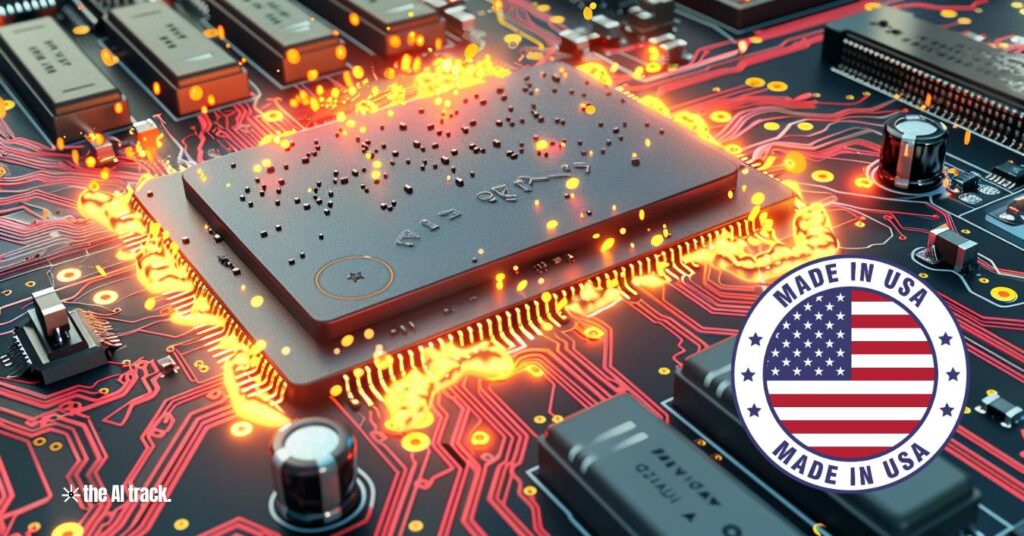In the intricate world of global technology, semiconductor manufacturing has emerged as a crucial battleground. These tiny chips, smaller than a postage stamp, are the heart of modern electronics, driving everything from smartphones to advanced military systems. Recognizing this, the U.S. government has embarked on a bold journey to reclaim a leadership position in this crucial domain. This article delves into the strategic moves and investments spearheaded by the U.S., highlighting the pivotal role of two major players: Taiwan Semiconductor Manufacturing Company (TSMC) and Samsung.
Jump to Sections
The CHIPS and Science Act: Catalyzing Change

Central to the U.S. strategy is the CHIPS and Science Act, a groundbreaking piece of legislation that marks a significant shift in the country’s approach to semiconductor manufacturing. With an allocation of $52.7 billion specifically for research and manufacturing subsidies, this Act is more than just a financial commitment; it’s a statement of intent.
Aimed at revitalizing a sector where the U.S. has seen its global manufacturing capacity drop from 37% in 1990 to about 12% in 2020, the Act addresses a critical vulnerability in the supply chain exposed by recent global events.
The CHIPS Act isn’t just about pumping money into the industry; it’s about laying the groundwork for a resurgence in domestic chip production. It seeks to lessen the U.S.’s reliance on semiconductor imports, particularly from regions like China and Taiwan, thereby addressing both economic and national security concerns. The investment goes beyond mere capacity expansion; it’s about fostering innovation and securing the U.S.’s spot at the high table of tech superpowers.
TSMC’s Groundbreaking Investment in Arizona
The Taiwan Semiconductor Manufacturing Company’s decision to invest $65 billion in Arizona stands as a cornerstone of the U.S. strategy to bolster semiconductor production. This monumental investment, the largest of its kind by TSMC outside Taiwan, is a vivid illustration of the CHIPS Act’s impact. TSMC plans to build three advanced semiconductor facilities, with the first expected to start producing 4nm and 5nm-class chips by 2025.
This move isn’t just about increasing production capacity; it’s a leap into the future of semiconductor technology. With plans to advance to 2nm and even sub-2nm technologies, TSMC’s Arizona facilities are poised to set new global standards. These developments hold the promise of powering the next generation of computing and consumer electronics, thereby solidifying the U.S.’s position in the global tech race.
Samsung’s Significant Role in Texas
Complementing TSMC’s initiatives is Samsung’s notable expansion in Taylor, Texas. With the U.S. government planning to award over $6 billion to Samsung, this investment will facilitate the construction of four facilities, including a $17 billion chipmaking plant. Samsung’s total U.S. investment is set to more than double to over $44 billion as part of this deal.
Samsung’s expansion in Texas represents another strategic maneuver under the CHIPS Act, augmenting the U.S.’s semiconductor production capabilities. The investment will not only increase chip output but also contribute significantly to research and development in the field, thereby enhancing the technological prowess of the U.S. semiconductor industry.

Economic Impacts and Job Creation
The economic implications of these large-scale semiconductor projects are profound. TSMC’s Arizona expansion alone is expected to create around 6,000 high-tech manufacturing jobs and over 20,000 construction jobs. This surge in employment opportunities is a boon not only for Arizona but for the U.S. economy at large. The $50 million allocation for training local workers is a testament to the commitment to not just create jobs, but also to invest in the workforce.
Similarly, Samsung’s Texas project is not just a monetary investment; it’s a catalyst for economic growth. Beyond the direct jobs created in the manufacturing facilities, these projects have a multiplier effect, generating thousands of indirect jobs and stimulating local economies. The investment in Texas will more than double Samsung’s U.S. commitment, echoing the CHIPS Act’s broader goal of economic revival through technological advancement.
A Global Battle in Semiconductor Manufacturing
In the global semiconductor industry, the U.S.’s recent initiatives signify a major strategic shift. Once a leader in this field, the U.S. had seen its dominance wane in favor of Asian manufacturers. With TSMC and Samsung’s investments, the U.S. is not just aiming to reclaim lost ground but also positioning itself at the forefront of the next wave of semiconductor innovation. This move is crucial in a context where semiconductor manufacturing has become a key factor in geopolitical and economic power plays, especially considering the increasing tensions and competition with China.

Influence on Tech Giants and Future Visions
The advancements in semiconductor manufacturing have profound implications for tech giants and future technological developments. Nvidia’s latest HGX H200 GPU is a prime example of products that stand to benefit from these advancements, necessitating cutting-edge chips that TSMC and Samsung are gearing up to produce. Nvidia’s HGX H200 GPU is set to leverage these new capabilities.
Similarly, Microsoft’s Maia 100 is another testament to the growing demands of the tech industry for more advanced semiconductors. These projects reflect the dynamic nature of the tech industry’s needs, which TSMC and Samsung’s expansions are well-positioned to meet. Microsoft’s Maia 100
Furthermore, the vision for AI chip factories, as envisioned by Sam Altman, underscores the evolving landscape of semiconductor use and its crucial role in future technologies. Altman’s dream points to a future where AI and advanced computing are even more deeply integrated into our lives, necessitating robust semiconductor manufacturing capabilities. Sam Altman’s Dream for a Network of AI Chip Factories
Challenges Ahead and Strategic Outlook
Despite the optimistic outlook, scaling semiconductor manufacturing in the U.S. is not without challenges. Issues ranging from labor disputes to supply chain complexities must be navigated. Moreover, the technological leap to more advanced manufacturing processes, like sub-2nm chips, involves significant R&D efforts and financial risk.
Yet, the strategic outlook remains positive. These investments by TSMC and Samsung are not mere business decisions; they are part of a larger strategy to ensure the U.S. remains at the cutting edge of technology. As the U.S. moves forward with this ambitious plan, it is poised to redefine the global semiconductor manufacturing landscape, enhancing its technological independence and securing its position as a leader in the global digital economy.
Key Takeaways
- The U.S. is investing in semiconductor manufacturing to lead globally.
- The CHIPS Act allocates $52.7 billion for research and manufacturing subsidies.
- TSMC invests $65 billion in Arizona for chip production.
- Samsung expands in Texas with over $6 billion in subsidies.
- These investments create thousands of jobs and boost economic growth.
- Challenges include labor disputes and technological advancements.
- The U.S. aims to lead in semiconductor manufacturing, benefiting tech giants like Nvidia and Microsoft.
Sources
- US to award Samsung up to $6.6 billion chip subsidy for Texas expansion, sources say | Reuters
- 8 Apr Biden gives TSMC over $6 billion for advanced chips in U.S. | Semafor
- TSMC gets $6.6 billion in cash and $5 billion in loans from CHIPS Act, plans third US fab | Tom’s Hardware




